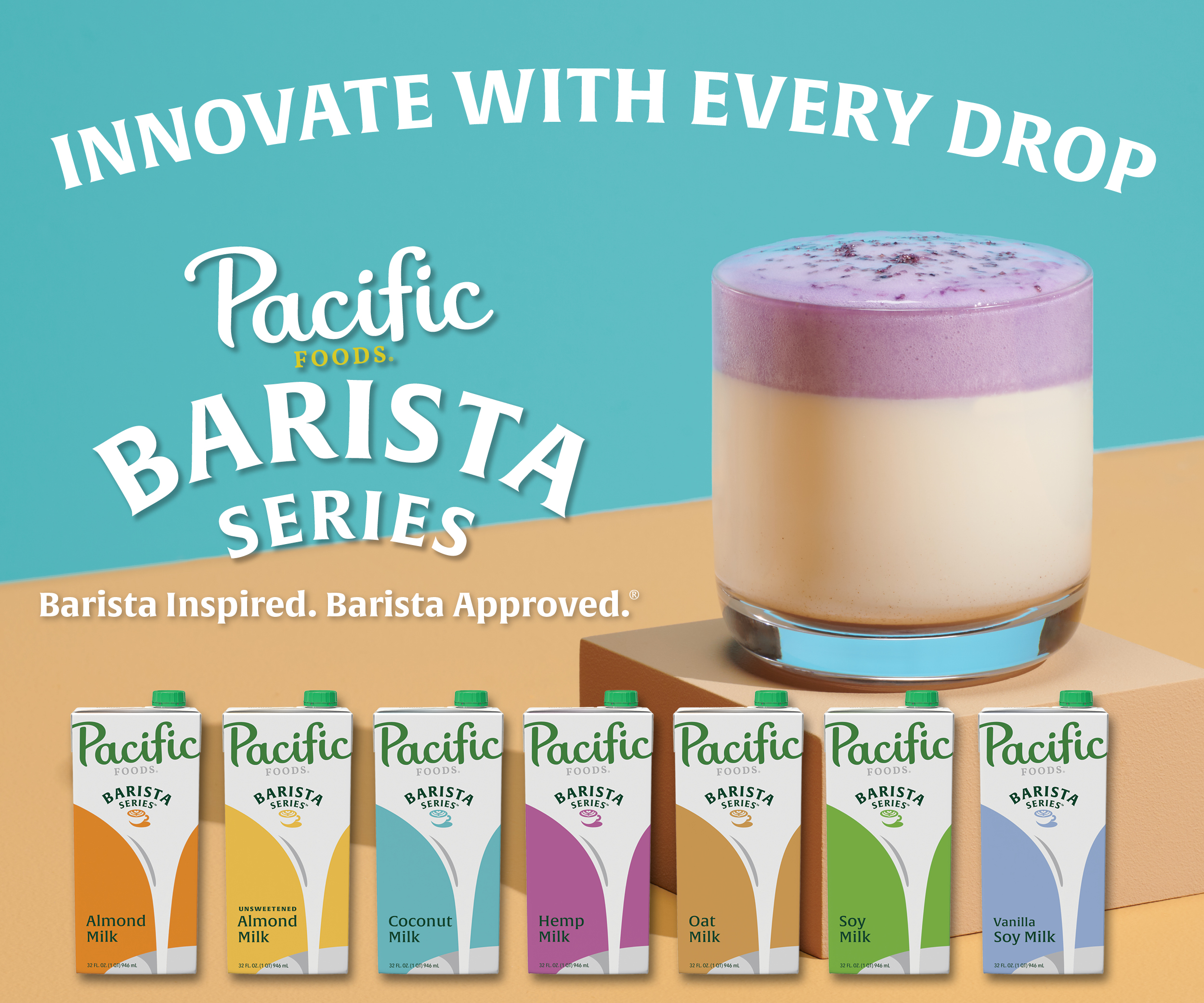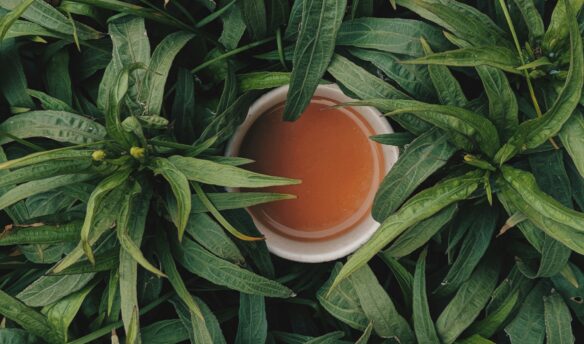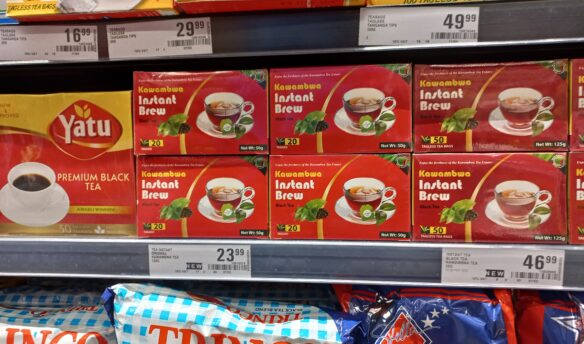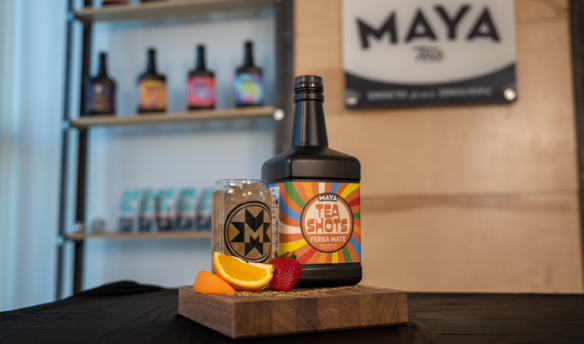[T]he organizers of Ride the Rockies, a weeklong tour de Colorado, provide participants with an elevation chart to show how much up and how much down the cyclists will traverse on each day of the event. The elevation charts of most races, either on foot or bike, roll with slight hills and long flats or are bell curves or, at worst, look like a group of mountains and valleys. The Ride the Rockies chart is one brutal peak followed by a sharp drop straight into another harsh ascent, nary a gully between. The chart could be a cardiogram of a cyclist doing Ride the Rockies.
Which is all to explain why during the 2010 ride Maria Uspenksi drank so much Gatorade she worried she had harmed her teeth. Maria, the owner of the specialty tea wholesaler The Tea Spot, resolved to switch to tea the next year. That wouldn’t be too easy though. During the ride, the cyclists sleep in tents and cook, if they cook, on camp stoves. Brewing tea on a camp stove after an eighty-mile thigh-torching climb was just too much. Instead of hot brewing and icing her tea, Maria began cold brewing white and green teas. “I’d throw them in a mason jar over night, in the morning I’d strain them out, and I’d have two or three amazing bottles of fresh tea ,” Maria says. “And I was shocked, because some of them tasted a lot better than they did hot brewed.”
Maria has worked since that ride to perfect both cold-brew blends and steeping baskets. For her, cold brewing is a continuation of the rise of the specialty tea industry. “Pure cold brewing has only been possible on teas that have been in the US for only ten or fifteen years,” Maria says. Before that, fine specialty teas were just too rare across much of the country.
Bill Waddington was among the few who had those teas, and he’s served cold-brewed tea at his Tea Source shops for nearly two decades. Bill is a jovial and gregarious guy who enjoys demystifying tea, whether it’s through tea production workshops or his bright and inviting teahouses in Minnesota. Bill believes cold brew provides a perfect entrance for customers new to loose-leaf tea. Plus, it lets him deliver a favorite punch line. “It’s the easiest way to make iced tea in the world,” he says. “You don’t even have to know how to boil water. How easy is that?”
Cold-brewed tea, at the risk of stating the obvious, differs from regular iced tea by being steeped in cold water, usually spending its long infusion time in a fridge. (Bill considers it iced tea, full stop, rather than some third category of tea. Again, simple.) Regular iced tea, when done right, requires the same care and attention as a meticulously made hot cup. That’s evinced, paradoxically, in the bizarre sweet tea recipes posted to cooking websites like Food and AllRecipes, which call for roiling water to be poured on tea bags that will steep for a dizzying fifteen minutes. What about the horrid bitterness this unleashes? Well, that’s why the recipes call for baking soda. Then, of course, the enamel-eating amounts of sugar.
“Once you teach it to your customers, the sales for the loose-leaf tea skyrocket.”
That’s egregious, yes, but for average iced tea drinkers that’s the preparation advice they’ll readily find. Tell them to measure out so many grams of loose leaf, hit this temperature with the water, and steep for this many minutes (or seconds, really), and you might as well have explained a science experiment.
Cold brew sidesteps that potentially daunting level of care. When Bill and Maria give the outlines for a cold-brew recipe, it sounds like a parody of lazy preparation. Drop a couple teaspoons of tea in a mason jar, pour water over it (no, it doesn’t really matter if its cold), put the jar in the fridge for several hours (or over night, that’s fine, too), then strain it. Enjoy. This simplicity is what makes cold brew so attractive to Bill. “Once you teach it to your customers, the sales for the loose-leaf tea skyrocket,” he says.
[W]hile cold brew accommodates specialty tea neophytes, what’s the worth of the preparation to a teahouse or an aficionado? Cold brewing takes a lot of time for a nice cup. When Maria makes her pitch for cold brew, she stresses two things: “It’s forgiving and it’s a different taste.” That different taste sets cold-brew tea apart, providing the argument that it is, actually, a third type of tea.
When tea professionals describe how cold brew tastes different they go straight for the word smooth. Cold-brew tea lacks even a hint of astringency or bite. Put a cup of cold brew next to a hot-brewed cup of the same tea and the two will be distinct. In the coffee world, some purists feel cold-brewed coffee is missing something and that lack, to some, is so profound that cold brew might not even count as coffee. That extreme position hasn’t been staked out in tea (not yet, or at least not loudly), and it likely won’t. What’s missing in a cup of cold brew is replaced by a heightened engagement with the flavors that are there. In some teas, cold brewing shows that the astringency, while providing a rounded mouth feel, also masked some fascinating flavors.
Let’s shrink to the molecular level and dive into the cool liquor of a steeping cold brew to find out what makes it different. As we hit the surface and begin to descend into the steeping vessel, this one happens to be a mason jar, you’ll notice it’s pretty calm in here. The water molecules and trapped oxygen are moving about, but in a lugubrious way, like an audience at a jam band concert. If we were in a hot brew, the molecules would be bashing around in a frenzied mosh pit.
As we go farther down, there are more and more molecules that have come from the tea. Most are various carbohydrates and amino acids, super-tasty flavor compounds. Every so often we see a polyphenol or a caffeine molecule, the latter are much bigger than the others. Now we’re getting to the leaves, which have mostly all sunk to the bottom. Here’s where the action is, where water molecules break tea compounds away from the leaves. Though here, the action is fairly calm. Donna Fellman, a tea expert and the online education director at The Beverage Group, explains that, “Heat is energy that has been put into water. That causes the molecules in the water to move faster. The faster they move the more energy they have. The more energy they have, the more capable they are of knocking things loose from the tea leaf into the water.”
“Cold-brew tea is an opportunity to have a more sophisticated palate experience.”
In a hot brew, the water molecules hit the leaves like wrecking balls, plowing away big and small molecules, and fast. Here in the cold brew, it’s more like an archeological excavation, slow brushwork that only pulls off highly soluble compounds. “The carbohydrates are going to come out into the water whether the water’s hot or cold because they’re the simplest,” Fellman says. The water can also pry off some simple amino acids. What don’t come off are compounds that add the deep and sometimes harsh flavors in hot tea. Polyphenols, for instance, cause astringency in tea, not a taste but that dry sensation you sometimes get. Caffeine is pure bitterness. Those classes of compounds do show up in cold-brewed tea, but at tiny fractions of their hot-brew numbers.
That means when we drink the cold brew, the solution’s chemical makeup is weighted toward the sweet carbohydrates and the umami amino acids, which in their variety and mix create a tea’s distinct flavors. The astringent polyphenols and bitter caffeine can’t take over the show. Cold-brewed tea is chemically different, if only slightly, from hot-brewed tea.
[A]t Samovar Tea Lounge in San Francisco, cold-brewed tea is integral to their menu. “Cold-brew tea is an opportunity to have a more sophisticated palate experience,” says Jesse Jacobs, Samovar’s founder and owner. Every night, before closing, a vat of cold-brew tea is prepared. The next day, after twelve to fourteen hours steeping, it’s ready to go, kept in the fridge and served without ice.
Like hot-brewed tea, different leaves will require different ratios to water. There’s not a lot of agreement on how much this differs from hot-brew ratios. Maria from The Tea Spot uses more tea for cold brews, while Jesse goes with less—just an indication of cold brewing’s newness.
Bill at Tea Source runs a similar service to Samovar’s, though with ice. The cold brew is a closing employee’s responsibility. They fill glass gallon jars to the brim with water and then put the tea in a tea sack and hold the sack in place with the screw-on lid. Into the fridge it goes. “In the morning we have beautiful cold-brew tea,” Bill says.
There is a downside to cold-brew service, Bill warns. The amount of cold brew you make is equal to the amount you sell. There’s no concentrate option, the way there is with regular iced tea, and jugs can bogart a lot of space in a fridge.
Now that the weather has made its turn to warm and blistering hot is on the way, cold-brew tea’s season has arrived, so try to make some room. Across the drink industry, this is the time we put down stouts and pick up pale ales; hot chocolate is replaced with apple juice; and red wines take a backseat to whites. Why not, at least a little, trade the warming, enjoyable astringency of hot tea for the crisp clean tones of a cold-brew. As Jesse says: “When you have artisan tea and you slowly extract the flavors, wow, you have a totally different game.”














